The Effect of Ignition Timing on the Emission and Combustion Characteristics for a Hydrogen-Fuelled ORP Engine at Lean-Burn Conditions
Abstract
:1. Introduction
2. Materials and Method
2.1. Configurations and Operation Theory of the Opposed Rotary Piston Engine
2.2. Merits Analysis of This Opposed Rotary Piston Engine
2.3. Computational Fluid Model

2.4. Boundary Condition Descriptions of the Scenarios
3. Results and Discussion
3.1. Combustion Characteristics

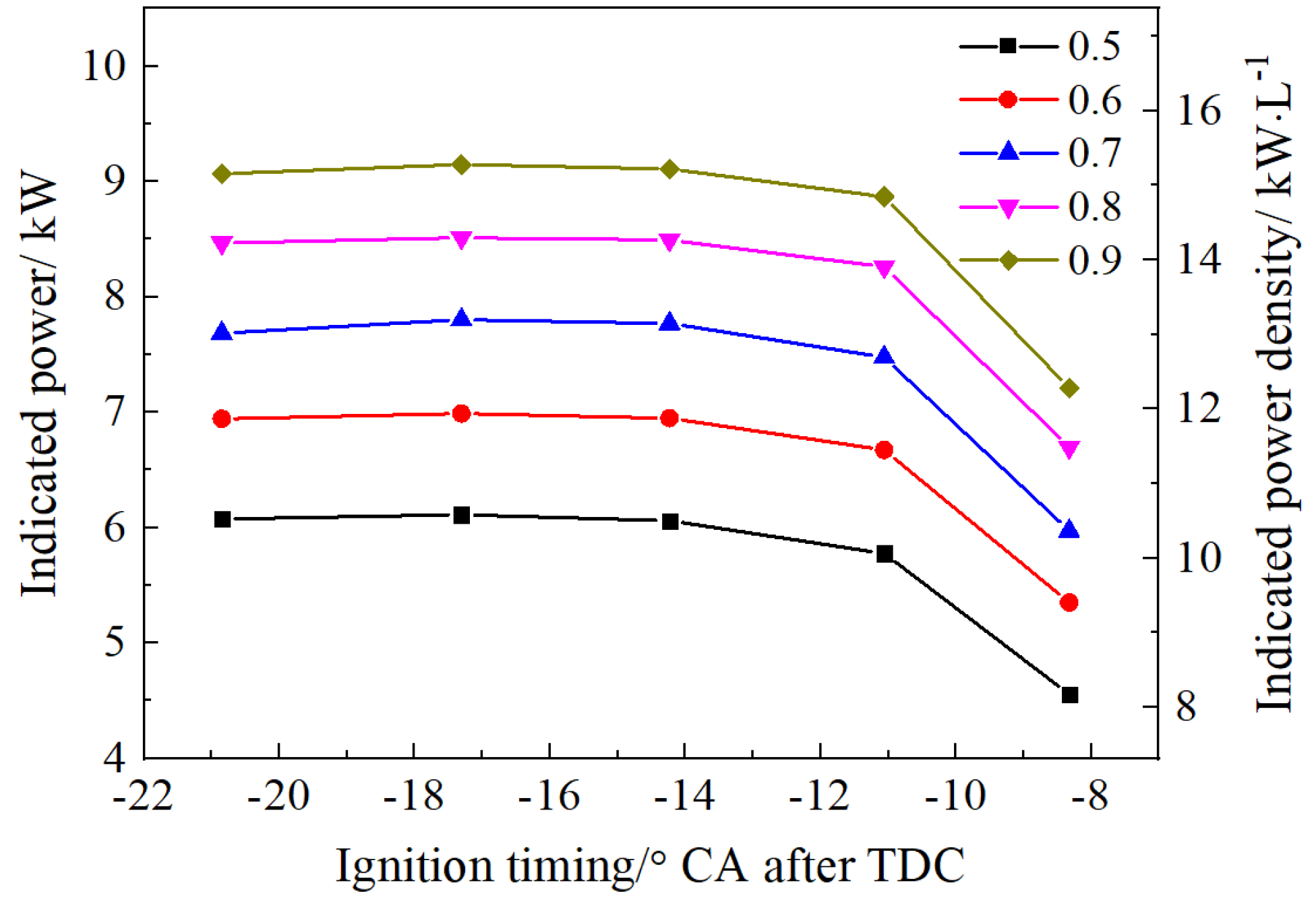
3.2. Energy Loss
3.3. NOx Emission Characteristics

4. Conclusions
- (1)
- Peak in-cylinder pressure was significantly dependent on the equivalence ratios and ignition timing. The value was increased approximately by 13 bar when the equivalence ratios were increased from 0.5 to 0.9. Crank angle corresponding to the peak in-cylinder pressure was slightly dependent on the ignition timing for individual equivalence ratios. Peak in-cylinder pressure was more sensitive to late ignition than early ignition. Discharge pressure was increased by increasing equivalence ratios over the same ignition timing; however, it showed minor difference over the ignition timing of −17.3° CA~−14.2° CA under the same equivalence ratio conditions. Special relative positions of the ignition systems to combustion chambers led to the different in-cylinder pressure evolutions from reciprocating engines under early ignition conditions.
- (2)
- The start of combustion, combustion phase, and combustion durations presented parabolic shapes with ignition timing, with the minimum value being around the ignition timing of −17.3° CA over individual equivalence ratios. Regarding the specific equivalence ratios, start of combustion was advanced by early ignition; however, the impacts on combustion phase and combustion durations were inconsistent by ignition timing. Maximum heat release rates were changed slightly by the ignition timing of −20.8° CA~−14.2° CA for the individual equivalence ratios; and the values decreased significantly for late ignition scenarios.
- (3)
- The optimal indicated thermal efficiency was higher than 41% for the equivalence ratios of 0.5~0.9. Indicated thermal efficiency showed minor dependency on the ignition timing for early ignition scenarios; however, the decrease was more than 10% for the ignition timing of −8.3° CA compared with the optimal efficiency. The minimum ISFC was lower than 68.5 g/kWh, corresponding to the equivalence ratio of 0.5 and ignition timing of −17.3° CA.
- (4)
- Heat loss in proportions of total fuel energy by cylinder walls increased with equivalence ratios. The relationships between the proportions and ignition timing were in parabolic shapes, with the maximum value corresponding to the ignition timing of −17.3° CA. Equivalence ratios showed minor impacts on the heat loss in proportions of total fuel energy by the exhaust.
- (5)
- Peak NOx concentration during combustion increased with equivalence ratios; however, the patterns depended on the ignition timing for NOx concentration at the end of expansion stroke due to the severe effects from reverse reactions during NOx formations. The maximum NOx emission factor was approximately 43 g/kWh under the equivalence ratio of 0.8; however, the minimum value was lower than 1 g/kWh under the equivalence ratio of 0.5.
Supplementary Materials
Author Contributions
Funding
Institutional Review Board Statement
Informed Consent Statement
Data Availability Statement
Acknowledgments
Conflicts of Interest
Nomenclature
| BDCs | bottom dead centres |
| BSFC | brake specific fuel consumption |
| CA | crank angle |
| CO | carbon monoxide |
| CO2 | carbon dioxide |
| DI | direct injection |
| EGR | exhaust gas recirculation |
| HC | hydrocarbon |
| ISFC | indicated specific fuel consumption |
| NOx | nitrogen oxides |
| ORP | opposed rotary piston |
| RNG | Re-Normalisation Group |
| TDCs | top dead centres |
References
- Kojima, N.; Tokai, A.; Nakakubo, T.; Nagata, Y. Policy evaluation of vehicle exhaust standards in Japan from 1995 to 2005 based on two human health risk indices for air pollution and global warming. Environ. Syst. Decis. 2016, 36, 229–238. [Google Scholar] [CrossRef]
- Acar, C.; Dincer, I. The potential role of hydrogen as a sustainable transportation fuel to combat global warming. Int. J. Hydrogen Energy 2020, 45, 3396–3406. [Google Scholar] [CrossRef]
- Buckeridge, D.L.; Glazier, R.; Harvey, B.J.; Escobar, M.; Amrhein, C.; Frank, J.W. Effect of motor vehicle emissions on respiratory health in an urban area. Environ. Health Perspect. 2002, 110, 293–300. [Google Scholar] [CrossRef] [PubMed]
- Gao, J.; Tian, G.; Sorniotti, A.; Karci, A.E.; Di Palo, R. Review of thermal management of catalytic converters to decrease engine emissions during cold start and warm up. Appl. Therm. Eng. 2019, 147, 177–187. [Google Scholar] [CrossRef]
- Wolfram, P.; Wiedmann, T. Electrifying Australian transport: Hybrid life cycle analysis of a transition to electric light-duty vehicles and renewable electricity. Appl. Energy 2017, 206, 531–540. [Google Scholar] [CrossRef]
- Gökce, K.; Ozdemir, A. An instantaneous optimization strategy based on efficiency maps for internal combustion engine/battery hybrid vehicles. Energy Convers. Manag. 2014, 81, 255–269. [Google Scholar] [CrossRef]
- Sadiq, G.A.; Al-Dadah, R.; Mahmoud, S. Development of rotary Wankel devices for hybrid automotive applications. Energy Convers. Manag. 2019, 202, 112159. [Google Scholar] [CrossRef]
- Gao, J.; Tian, G.; Ma, C.; Xing, S.; Jenner, P. Performance explorations of a naturally aspirated opposed rotary piston engine fuelled with hydrogen under part load and stoichiometric conditions using a numerical simulation approach. Energy 2021, 222, 120003. [Google Scholar] [CrossRef]
- Gao, J.; Tian, G.; Ma, C.; Balasubramanian, D.; Xing, S.; Jenner, P. Numerical investigations of combustion and emissions characteristics of a novel small scale opposed rotary piston engine fuelled with hydrogen at wide open throttle and stoichiometric conditions. Energy Convers. Manag. 2020, 221, 113178. [Google Scholar] [CrossRef]
- Gong, C.; Yi, L.; Zhang, Z.; Sun, J.; Liu, F. Assessment of ultra-lean burn characteristics for a stratified-charge direct-injection spark-ignition methanol engine under different high compression ratios. Appl. Energy 2020, 261, 114478. [Google Scholar] [CrossRef]
- Chen, W.; Pan, J.; Zuo, Q.; Zhang, J.; Wang, Z.; Zhang, B.; Zhu, G.; Fan, B. Combustion performance improvement of a diesel fueled Wankel stratified-charge combustion engine by optimizing assisted ignition strategy. Energy Convers. Manag. 2020, 205, 112324. [Google Scholar] [CrossRef]
- Qian, Y.; Wang, J.; Li, Z.; Jiang, C. Improvement of combustion performance and emissions in a gasoline direct injection (GDI) engine by modulation of fuel volatility. Fuel 2020, 268, 117369. [Google Scholar] [CrossRef]
- Gong, C.; Sun, J.; Liu, F. Numerical study of twin-spark plug arrangement effects on flame, combustion and emissions of a medium compression ratio direct-injection methanol engine. Fuel 2020, 279, 118427. [Google Scholar] [CrossRef]
- Amrouche, F.; Erickson, P.; Park, J.; Varnhagen, S. An experimental evaluation of ultra-lean burn capability of a hydrogen-enriched ethanol-fuelled Wankel engine at full load condition. Int. J. Hydrogen Energy 2016, 41, 19231–19242. [Google Scholar] [CrossRef]
- Su, T.; Ji, C.; Wang, S.; Shi, L.; Yang, J.; Cong, X. Reducing the idle speed of a gasoline rotary engine with hydrogen addition. Int. J. Hydrogen Energy 2017, 42, 23218–23226. [Google Scholar] [CrossRef]
- Shi, C.; Ji, C.; Wang, S.; Yang, J.; Li, X.; Ge, Y. Effects of hydrogen direct-injection angle and charge concentration on gasoline-hydrogen blending lean combustion in a Wankel engine. Energy Convers. Manag. 2019, 187, 316–327. [Google Scholar] [CrossRef]
- Ozcanli, M.; Bas, O.; Akar, M.A.; Yildizhan, S.; Serin, H. Recent studies on hydrogen usage in Wankel SI engine. Int. J. Hydrogen Energy 2018, 43, 18037–18045. [Google Scholar] [CrossRef]
- Chen, H.; Pan, C.-Y.; Xu, H.-J.; Deng, H.; Han, C. Analysis on structural characteristics of rotors in twin-rotor cylinder-embedded piston engine. J. Cent. South Univ. 2014, 21, 2240–2252. [Google Scholar] [CrossRef]
- Zou, T.-A.; Xu, H.-J.; Pan, C.-Y.; Xu, X.-J.; Chen, H. Mathematical modeling and analysis of thermodynamic processes in a twin-rotor piston engine. J. Cent. South Univ. 2014, 21, 4163–4171. [Google Scholar] [CrossRef]
- Pan, D.; Xu, H.; Liu, B.; Yang, C. Research on sealing characteristics of annular power cylinder based on twin-rotor piston engine. Proc. Inst. Mech. Eng. Part C J. Mech. Eng. Sci. 2021, 236, 09544062211021440. [Google Scholar] [CrossRef]
- Gao, J.; Tian, G.; Jenner, P.; Burgess, M.; Emhardt, S. Preliminary explorations of the performance of a novel small scale opposed rotary piston engine. Energy 2020, 190, 116402. [Google Scholar] [CrossRef]
- You, J.; Liu, Z.; Wang, Z.; Wang, D.; Xu, Y. Impact of natural gas injection strategies on combustion and emissions of a dual fuel natural gas engine ignited with diesel at low loads. Fuel 2020, 260, 116414. [Google Scholar] [CrossRef]
- Pastor, J.V.; García, A.; Micó, C.; García-Carrero, A.A. Experimental study of influence of Liquefied Petroleum Gas addition in Hydrotreated Vegetable Oil fuel on ignition delay, flame lift off length and soot emission under diesel-like conditions. Fuel 2020, 260, 116377. [Google Scholar] [CrossRef]
- Verhelst, S.; Turner, J.W.; Sileghem, L.; Vancoillie, J. Methanol as a fuel for internal combustion engines. Prog. Energy Combust. Sci. 2019, 70, 43–88. [Google Scholar] [CrossRef]
- Gong, C.; Zhang, Z.; Sun, J.; Chen, Y.; Liu, F. Computational study of nozzle spray-line distribution effects on stratified mixture formation, combustion and emissions of a high compression ratio DISI methanol engine under lean-burn condition. Energy 2020, 205, 118080. [Google Scholar] [CrossRef]
- Del Pecchia, M.; Pessina, V.; Berni, F.; d’Adamo, A.; Fontanesi, S. Gasoline-ethanol blend formulation to mimic laminar flame speed and auto-ignition quality in automotive engines. Fuel 2020, 264, 116741. [Google Scholar] [CrossRef]
- Rajak, U.; Nashine, P.; Verma, T.N. Characteristics of microalgae spirulina biodiesel with the impact of n-butanol addition on a CI engine. Energy 2019, 189, 116311. [Google Scholar] [CrossRef]
- Şanli, B.G.; Uludamar, E.; Özcanli, M. Evaluation of energetic-exergetic and sustainability parameters of biodiesel fuels produced from palm oil and opium poppy oil as alternative fuels in diesel engines. Fuel 2019, 258, 116116. [Google Scholar] [CrossRef]
- Chan, J.; Tsolakis, A.; Herreros, J.; Kallis, K.; Hergueta, C.; Sittichompoo, S.; Bogarra, M. Combustion, gaseous emissions and PM characteristics of Di-Methyl Carbonate (DMC)-gasoline blend on gasoline Direct Injection (GDI) engine. Fuel 2020, 263, 116742. [Google Scholar] [CrossRef]
- Gao, J.; Wang, X.; Song, P.; Tian, G.; Ma, C. Review of the backfire occurrences and control strategies for port hydrogen injection internal combustion engines. Fuel 2022, 307, 121553. [Google Scholar] [CrossRef]
- Boretti, A. Hydrogen internal combustion engines to 2030. Int. J. Hydrogen Energy 2020, 45, 23692–23703. [Google Scholar] [CrossRef]
- Cho, E.S.; Ruminski, A.M.; Aloni, S.; Liu, Y.-S.; Guo, J.; Urban, J.J. Graphene oxide/metal nanocrystal multilaminates as the atomic limit for safe and selective hydrogen storage. Nat. Commun. 2016, 7, 10804. [Google Scholar] [CrossRef] [PubMed]
- Ishii, M.; Wakai, S. Electron-Based Bioscience and Biotechnology; Springer: Berlin/Heidelberg, Germany, 2020; pp. 81–99. [Google Scholar]
- Akal, D.; Öztuna, S.; Büyükakın, M.K. A review of hydrogen usage in internal combustion engines (gasoline-Lpg-diesel) from combustion performance aspect. Int. J. Hydrogen Energy 2020, 45, 35257–35268. [Google Scholar] [CrossRef]
- Gürbüz, H.; Akçay, İ.H. Evaluating the effects of boosting intake-air pressure on the performance and environmental-economic indicators in a hydrogen-fueled SI engine. Int. J. Hydrogen Energy 2021, 46, 28801–28810. [Google Scholar] [CrossRef]
- Shi, C.; Ji, C.; Wang, S.; Yang, J.; Li, X.; Ge, Y. Numerical simulation on combustion process of a hydrogen direct-injection stratified gasoline Wankel engine by synchronous and asynchronous ignition modes. Energy Convers. Manag. 2019, 183, 14–25. [Google Scholar] [CrossRef]
- Su, T.; Ji, C.; Wang, S.; Cong, X.; Shi, L.; Yang, J. Improving the lean performance of an n-butanol rotary engine by hydrogen enrichment. Energy Convers. Manag. 2018, 157, 96–102. [Google Scholar] [CrossRef]
- Gong, C.; Li, Z.; Yi, L.; Liu, F. Comparative study on combustion and emissions between methanol port-injection engine and methanol direct-injection engine with H2-enriched port-injection under lean-burn conditions. Energy Convers. Manag. 2019, 200, 112096. [Google Scholar] [CrossRef]
- Gong, C.; Li, Z.; Yi, L.; Sun, J.; Liu, F. Comparative analysis of various combustion phase control methods in a lean-burn H2/methanol fuel dual-injection engine. Fuel 2020, 262, 116592. [Google Scholar] [CrossRef]
- Du, Y.; Yu, X.; Liu, L.; Li, R.; Zuo, X.; Sun, Y. Effect of addition of hydrogen and exhaust gas recirculation on characteristics of hydrogen gasoline engine. Int. J. Hydrogen Energy 2017, 42, 8288–8298. [Google Scholar] [CrossRef]
- Gong, C.; Li, Z.; Huang, K.; Liu, F. Research on the performance of a hydrogen/methanol dual-injection assisted spark-ignition engine using late-injection strategy for methanol. Fuel 2020, 260, 116403. [Google Scholar] [CrossRef]
- Gong, C.; Li, Z.; Sun, J.; Liu, F. Evaluation on combustion and lean-burn limit of a medium compression ratio hydrogen/methanol dual-injection spark-ignition engine under methanol late-injection. Appl. Energy 2020, 277, 115622. [Google Scholar] [CrossRef]
- Yu, X.; Du, Y.; Sun, P.; Liu, L.; Wu, H.; Zuo, X. Effects of hydrogen direct injection strategy on characteristics of lean-burn hydrogen–gasoline engines. Fuel 2017, 208, 602–611. [Google Scholar] [CrossRef]
- Shi, C.; Ji, C.; Ge, Y.; Wang, S.; Yang, J.; Wang, H. Effects of split direct-injected hydrogen strategies on combustion and emissions performance of a small-scale rotary engine. Energy 2021, 215, 119124. [Google Scholar] [CrossRef]
- Gao, J.; Xing, S.; Tian, G.; Ma, C.; Zhao, M.; Jenner, P. Numerical simulation on the combustion and NOx emission characteristics of a turbocharged opposed rotary piston engine fuelled with hydrogen under wide open throttle conditions. Fuel 2021, 285, 119210. [Google Scholar] [CrossRef]
- Gao, J.; Tian, G.; Ma, C.; Xing, S.; Jenner, P. Lean-burn characteristics of a turbocharged opposed rotary piston engine fuelled with hydrogen at low engine speed conditions. Int. J. Hydrogen Energy 2021, 46, 1219–1233. [Google Scholar] [CrossRef]
- Gao, J.; Tian, G.; Ma, C.; Xing, S.; Huang, L. Numerical simulation on lean-burn characteristics of a naturally aspirated opposed rotary piston engine fuelled with hydrogen at wide open throttle conditions. J. Clean. Prod. 2021, 285, 124887. [Google Scholar] [CrossRef]
- Gao, J.; Tian, G.; Ma, C.; Xing, S.; Huang, L. Three-dimensional numerical simulations on the effect of ignition timing on combustion characteristics, nitrogen oxides emissions, and energy loss of a hydrogen fuelled opposed rotary piston engine over wide open throttle conditions. Fuel 2021, 288, 119722. [Google Scholar] [CrossRef]
- Gao, J.; Tian, G.; Ma, C.; Xing, S.; Huang, L. Explorations of the impacts on a hydrogen fuelled opposed rotary piston engine performance by ignition timing under part load conditions. Int. J. Hydrogen Energy 2021, 46, 11994–12008. [Google Scholar] [CrossRef]
- ANSYS. ANSYS Fluent Theory Guide; ANSYS: Canonsburg, PA, USA, 2013. [Google Scholar]
- Chapter 17: Modeling Pollutant Formation. In FLUENT; FLUENT, Inc.: New York, NY, USA, 2001.
- Luo, Q.-H.; Hu, J.-B.; Sun, B.-G.; Liu, F.-S.; Wang, X.; Li, C.; Bao, L.-Z. Experimental investigation of combustion characteristics and NOx emission of a turbocharged hydrogen internal combustion engine. Int. J. Hydrogen Energy 2019, 44, 5573–5584. [Google Scholar] [CrossRef]
- Arroyo, J.; Moreno, F.; Muñoz, M.; Monné, C. Experimental study of ignition timing and supercharging effects on a gasoline engine fueled with synthetic gases extracted from biogas. Energy Convers. Manag. 2015, 97, 196–211. [Google Scholar] [CrossRef]
- Hu, E.; Huang, Z. Optimization on Ignition Timing and EGR Ratio of a Spark-Ignition Engine Fuelled with Natural Gas-Hydrogen Blends; SAE Technical Paper Report No. 0148-7191; SAE: Detroit, MI, USA, 2011. [Google Scholar]
- Jabbr, A.I.; Vaz, W.S.; Khairallah, H.A.; Koylu, U.O. Multi-objective optimization of operating parameters for hydrogen-fueled spark-ignition engines. Int. J. Hydrogen Energy 2016, 41, 18291–18299. [Google Scholar] [CrossRef]
- Sari, R.; Golke, D.; Enzweiler, H.; Salau, N.; Pereira, F.; Martins, M. Exploring optimal operating conditions for wet ethanol use in spark ignition engines. Appl. Therm. Eng. 2018, 138, 523–533. [Google Scholar] [CrossRef]
- Bhasker, J.P.; Porpatham, E. Effects of compression ratio and hydrogen addition on lean combustion characteristics and emission formation in a Compressed Natural Gas fuelled spark ignition engine. Fuel 2017, 208, 260–270. [Google Scholar] [CrossRef]
- Hotta, S.K.; Sahoo, N.; Mohanty, K.; Kulkarni, V. Ignition timing and compression ratio as effective means for the improvement in the operating characteristics of a biogas fueled spark ignition engine. Renew. Energy 2020, 150, 854–867. [Google Scholar] [CrossRef]
- Pan, M.; Wei, H.; Feng, D.; Pan, J.; Huang, R.; Liao, J. Experimental study on combustion characteristics and emission performance of 2-phenylethanol addition in a downsized gasoline engine. Energy 2018, 163, 894–904. [Google Scholar] [CrossRef]
- Ortiz-Imedio, R.; Ortiz, A.; Urroz, J.; Diéguez, P.; Gorri, D.; Gandía, L.; Ortiz, I. Comparative performance of coke oven gas, hydrogen and methane in a spark ignition engine. Int. J. Hydrogen Energy 2020, 46, 17572–17586. [Google Scholar] [CrossRef]
- Ma, F.; Wang, Y.; Liu, H.; Li, Y.; Wang, J.; Ding, S. Effects of hydrogen addition on cycle-by-cycle variations in a lean burn natural gas spark-ignition engine. Int. J. Hydrogen Energy 2008, 33, 823–831. [Google Scholar] [CrossRef]
- Zareei, J.; Rohani, A. Optimization and study of performance parameters in an engine fueled with hydrogen. Int. J. Hydrogen Energy 2020, 45, 322–336. [Google Scholar] [CrossRef]
- Wang, X.; Sun, B.-G.; Luo, Q.-H. Energy and exergy analysis of a turbocharged hydrogen internal combustion engine. Int. J. Hydrogen Energy 2019, 44, 5551–5563. [Google Scholar] [CrossRef]
- He, B.-Q.; Xu, S.-P.; Fu, X.-Q.; Zhao, H. Combustion and emission characteristics of an ultra-lean burn gasoline engine with dimethyl ether auto-ignition. Energy 2020, 209, 118437. [Google Scholar] [CrossRef]
- Duan, X.; Li, Y.; Liu, J.; Guo, G.; Fu, J.; Zhang, Q.; Zhang, S.; Liu, W. Experimental study the effects of various compression ratios and spark timing on performance and emission of a lean-burn heavy-duty spark ignition engine fueled with methane gas and hydrogen blends. Energy 2019, 169, 558–571. [Google Scholar] [CrossRef]
- Nuthan, P.B.S.; Kumar, G.N. Influence of ignition timing on performance and emission characteristics of an SI engine fueled with equi-volume blend of methanol and gasoline. Energy Sources Part A Recovery Util. Environ. Eff. 2019, 1–15. [Google Scholar] [CrossRef]
- Fan, B.; Zhang, Y.; Pan, J.; Liu, Y.; Chen, W.; Otchere, P.; Wei, A.; He, R. The influence of hydrogen injection strategy on mixture formation and combustion process in a port injection (PI) rotary engine fueled with natural gas/hydrogen blends. Energy Convers. Manag. 2018, 173, 527–538. [Google Scholar] [CrossRef]
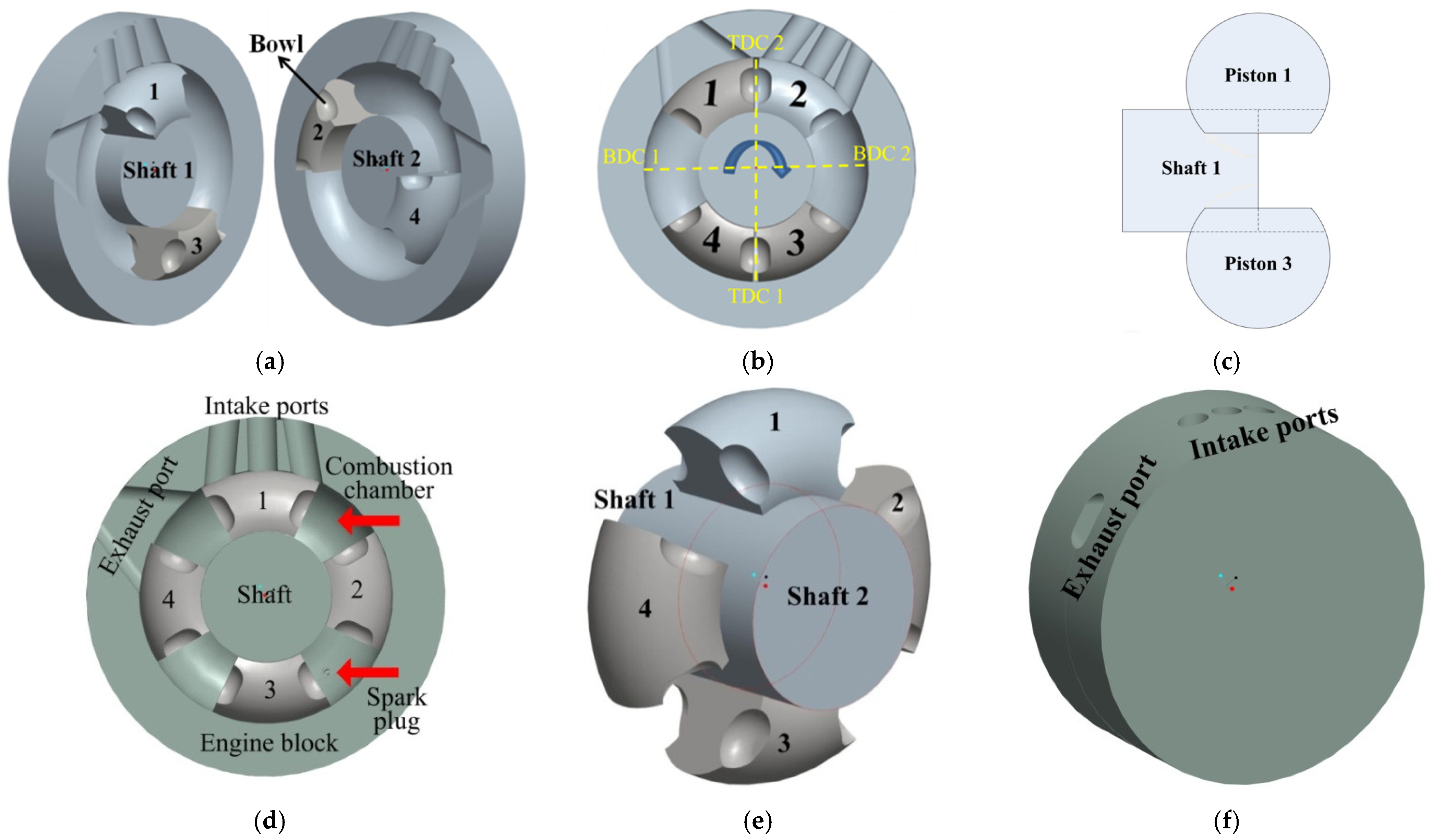
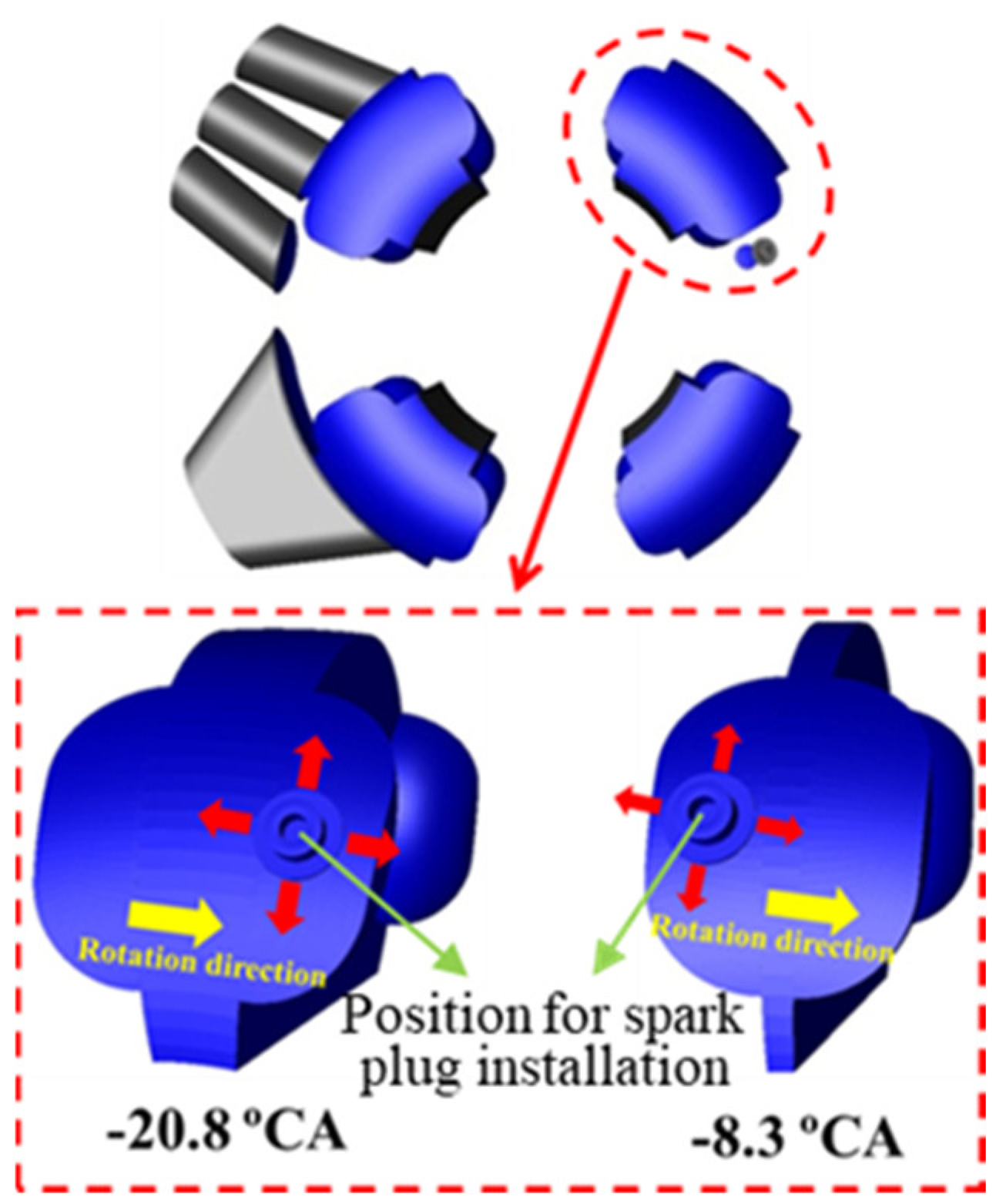
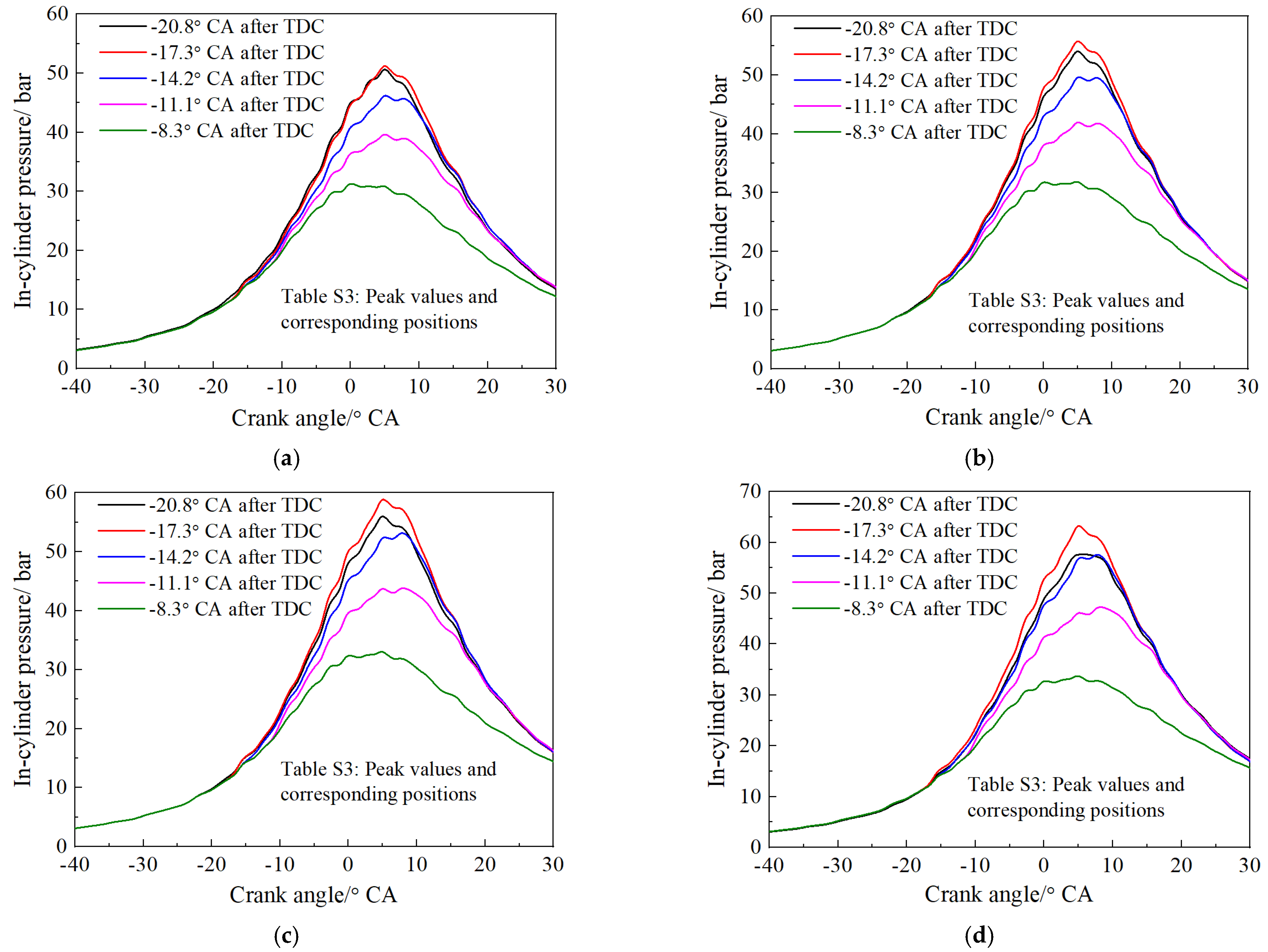

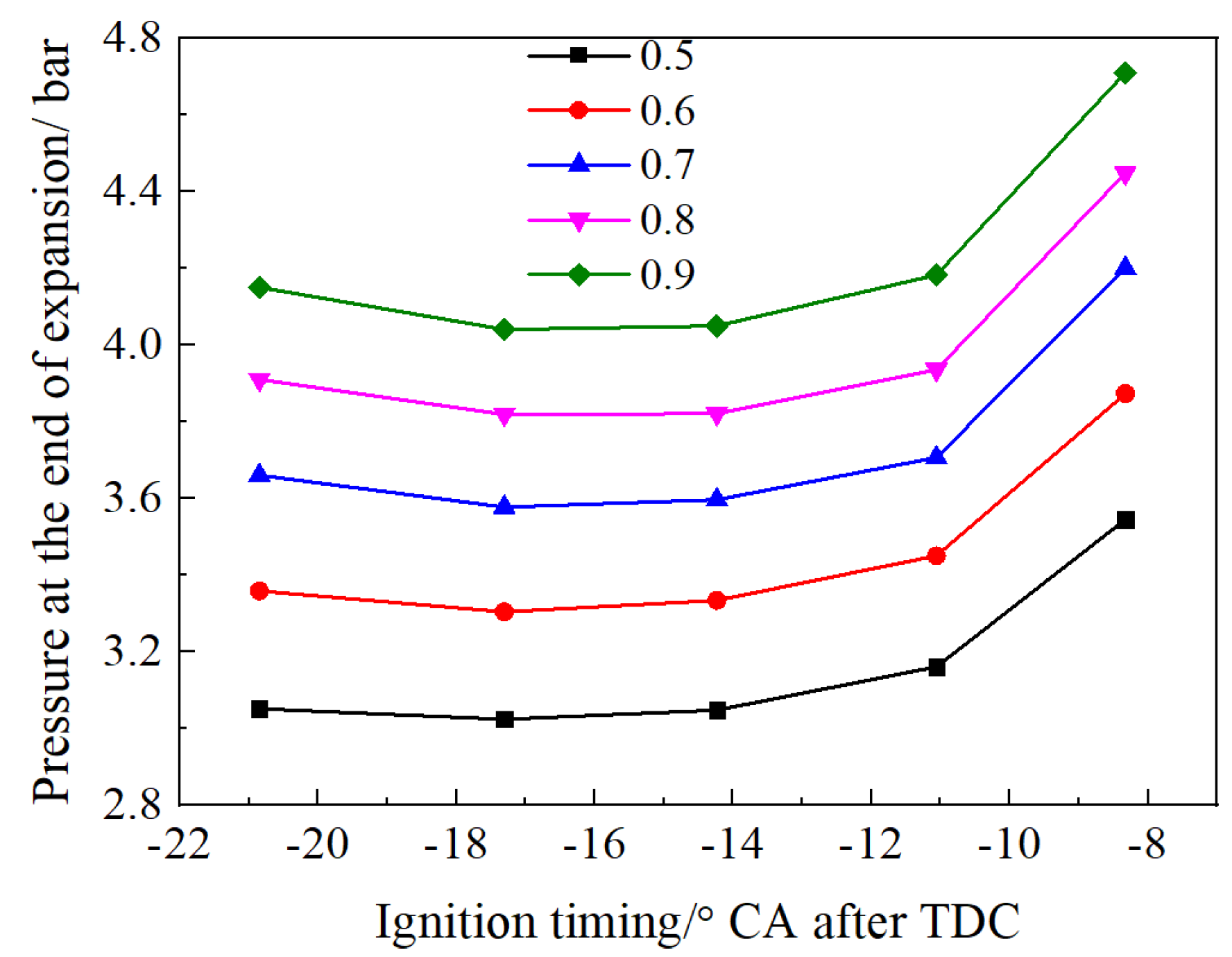
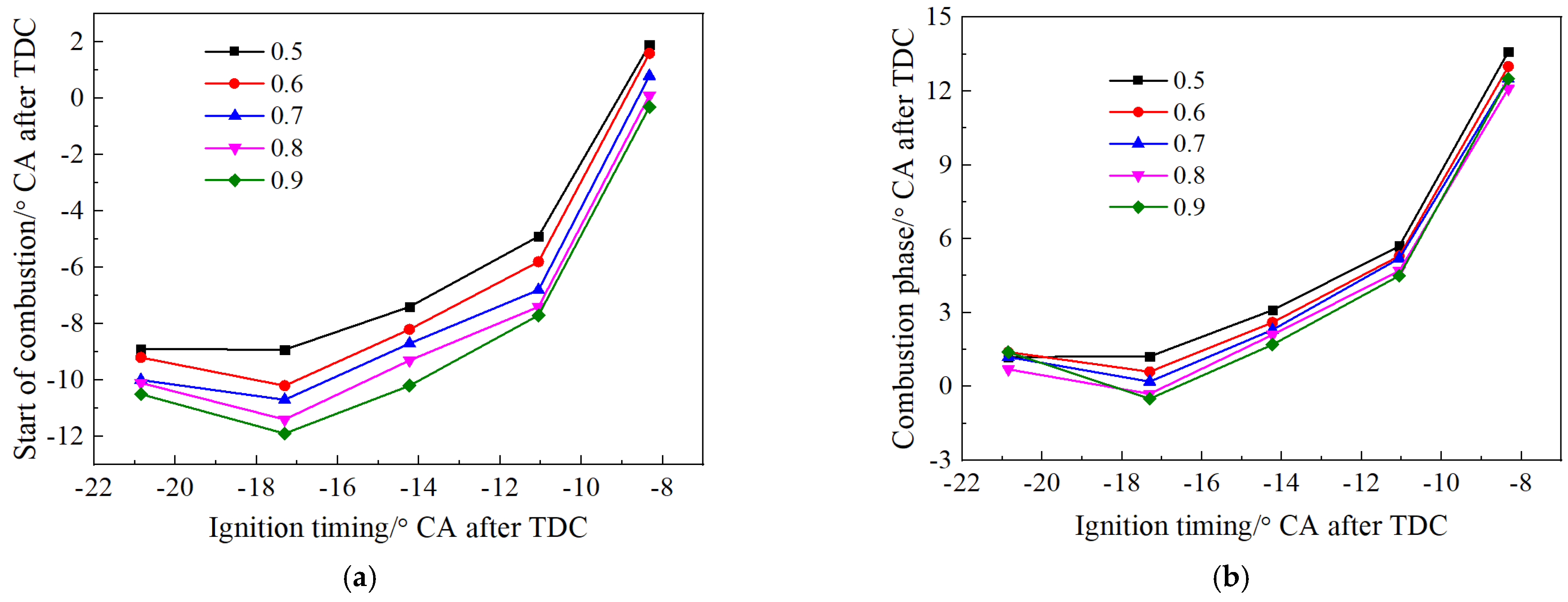

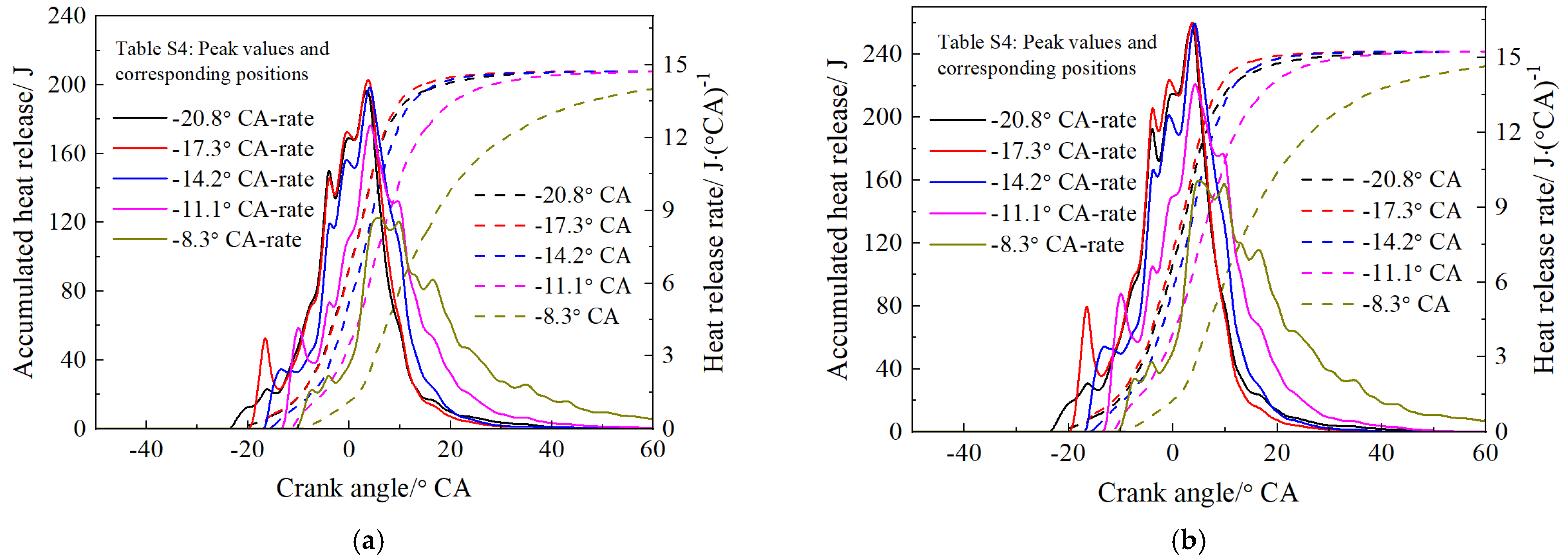

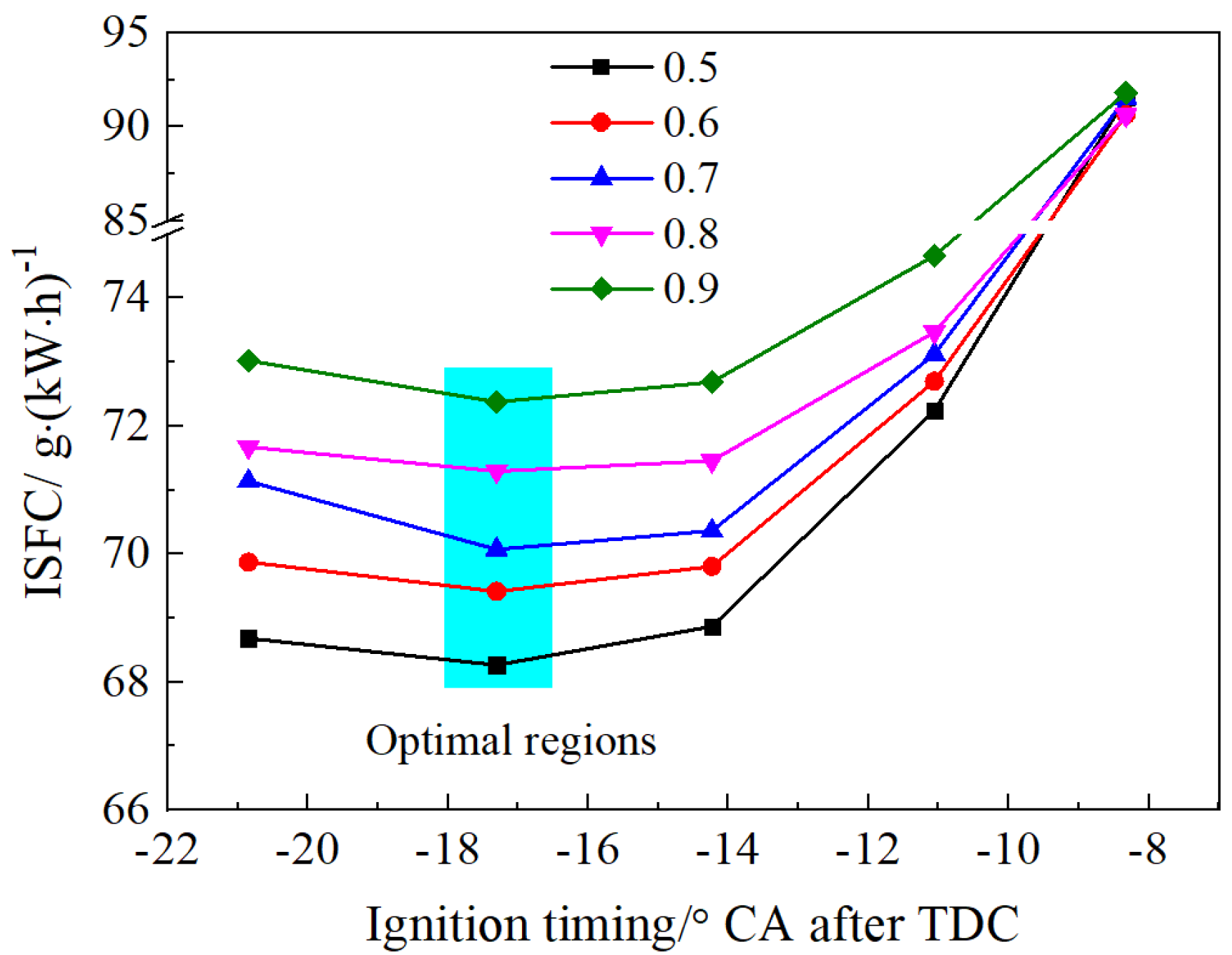

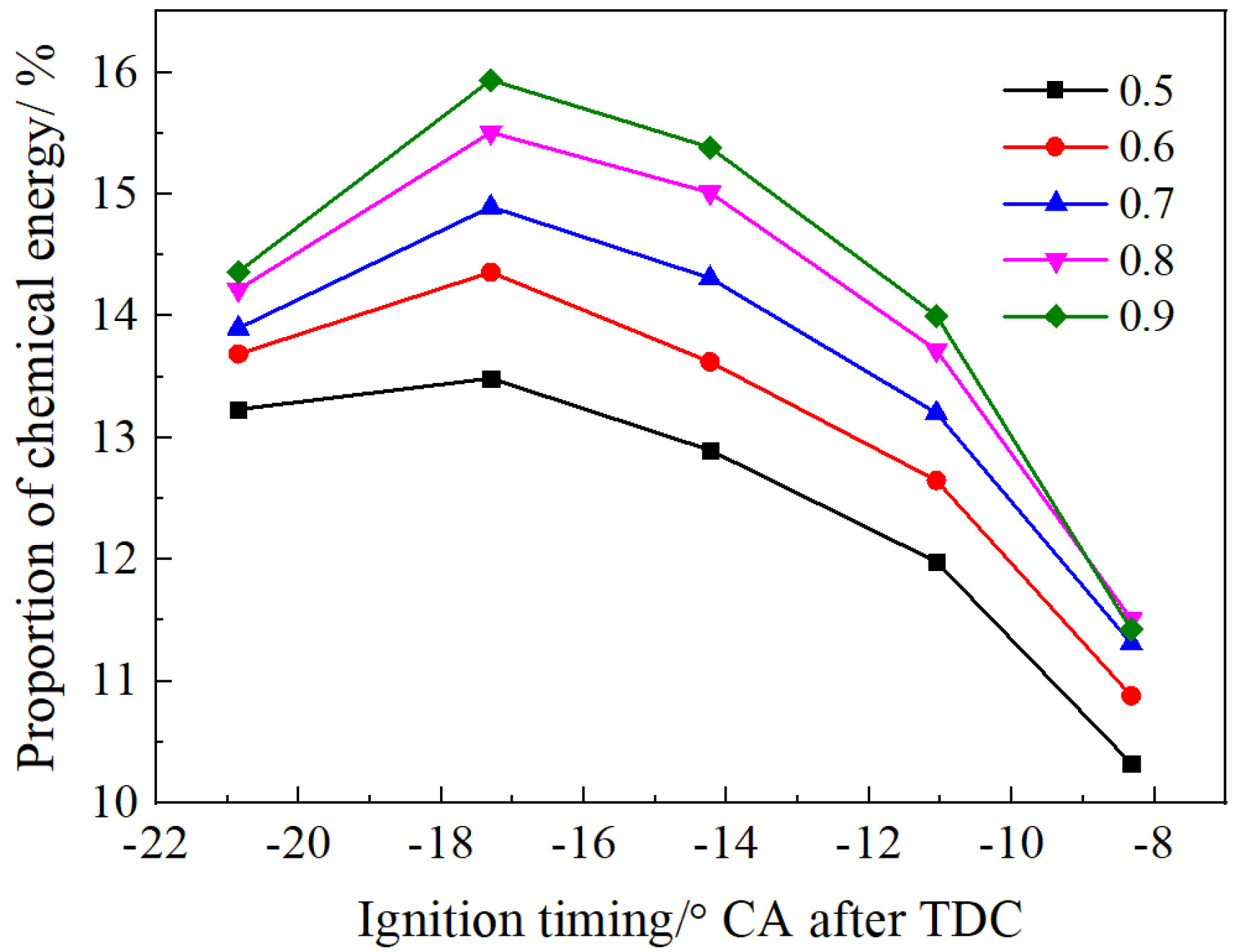

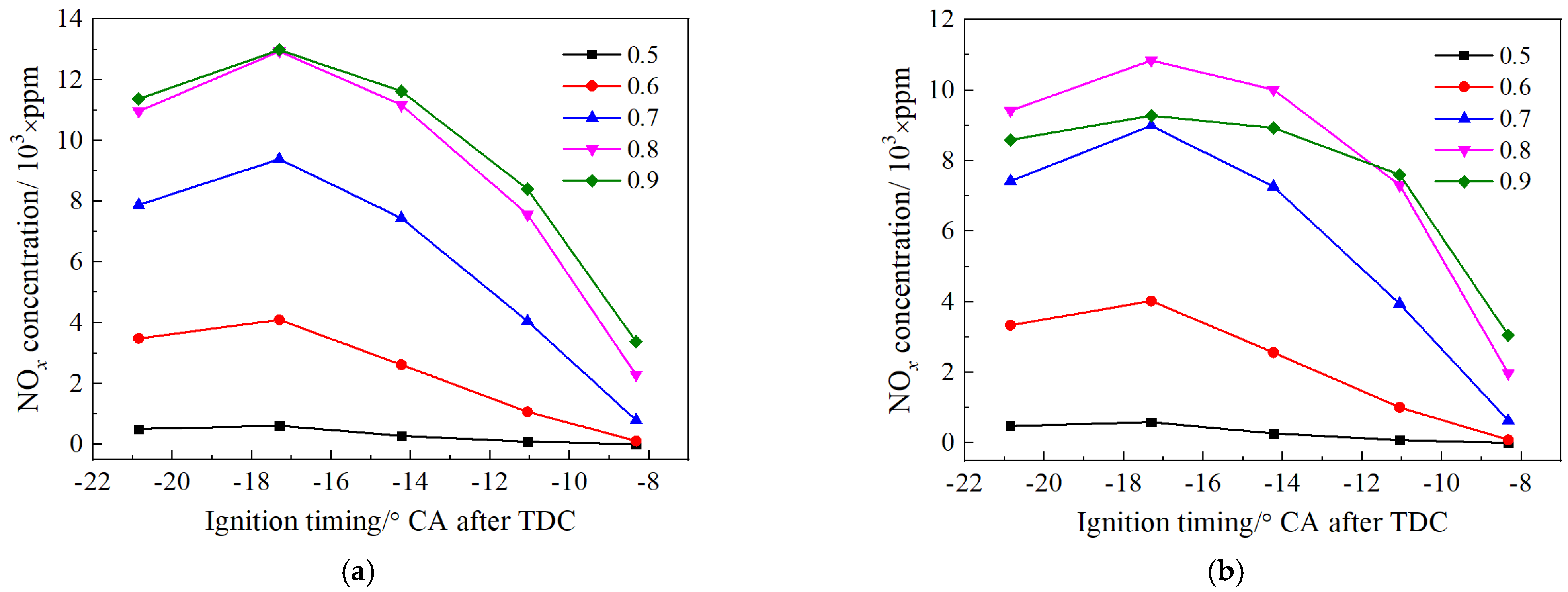
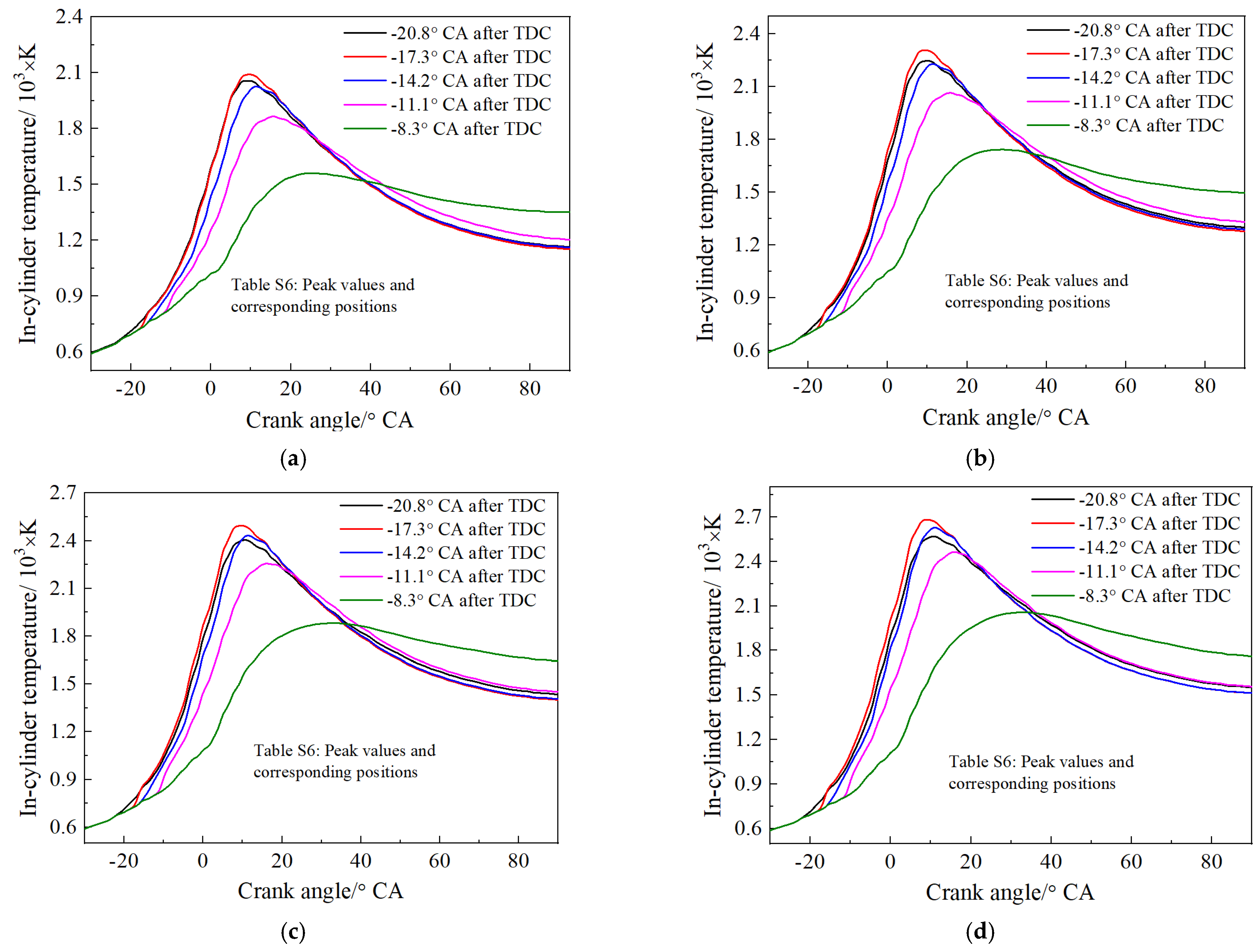
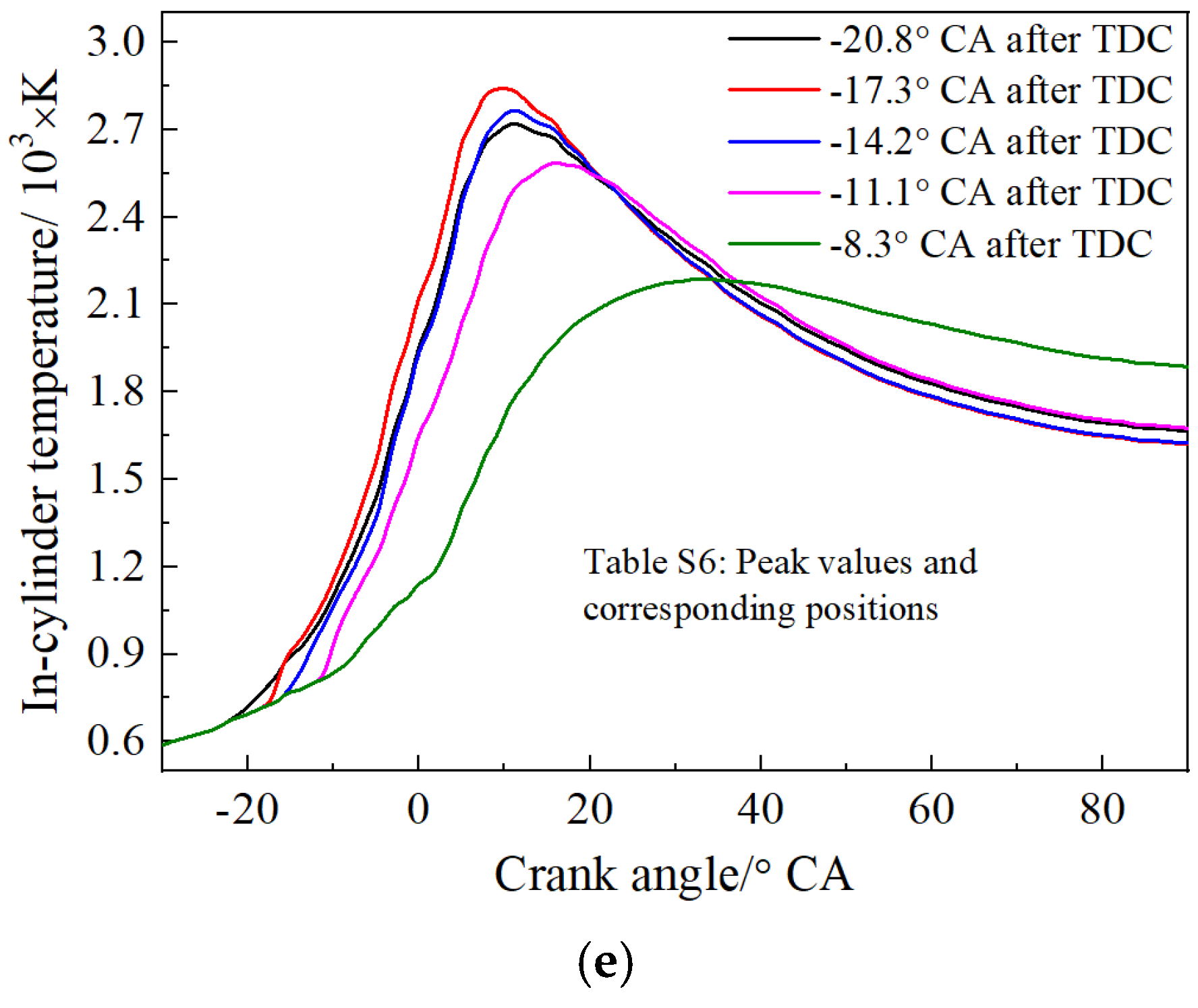
| Scenarios | 1~5 | 6~10 | 11~15 | 16~20 | 21~25 |
|---|---|---|---|---|---|
| Equivalence ratio (ER) | 0.5 | 0.6 | 0.7 | 0.8 | 0.9 |
| Rotation speed/RPM | 1000 | ||||
| Throttle opening/% | 100% | ||||
| Intake pressure/bar | 1.0 | ||||
| Intake temperature/K | 293 | ||||
| Cylinder wall temperature/K | 573 | ||||
| Outlet pressure/bar | 1.0 | ||||
| Fuel type | H2 | ||||
| Time step size/×10−5 s | 6.0 | ||||
| Time steps per cycle | 1000 | ||||
| Ignition timing (time step)/ °CA after TDC | −20.8 (1060); −17.3 (1070); −14.2 (1080); −11.1 (1090); −8.3 (1100) | ||||
Publisher’s Note: MDPI stays neutral with regard to jurisdictional claims in published maps and institutional affiliations. |
© 2022 by the authors. Licensee MDPI, Basel, Switzerland. This article is an open access article distributed under the terms and conditions of the Creative Commons Attribution (CC BY) license (https://creativecommons.org/licenses/by/4.0/).
Share and Cite
Huang, J.; Gao, J.; Yang, C.; Tian, G.; Ma, C. The Effect of Ignition Timing on the Emission and Combustion Characteristics for a Hydrogen-Fuelled ORP Engine at Lean-Burn Conditions. Processes 2022, 10, 1534. https://doi.org/10.3390/pr10081534
Huang J, Gao J, Yang C, Tian G, Ma C. The Effect of Ignition Timing on the Emission and Combustion Characteristics for a Hydrogen-Fuelled ORP Engine at Lean-Burn Conditions. Processes. 2022; 10(8):1534. https://doi.org/10.3390/pr10081534
Chicago/Turabian StyleHuang, Junfeng, Jianbing Gao, Ce Yang, Guohong Tian, and Chaochen Ma. 2022. "The Effect of Ignition Timing on the Emission and Combustion Characteristics for a Hydrogen-Fuelled ORP Engine at Lean-Burn Conditions" Processes 10, no. 8: 1534. https://doi.org/10.3390/pr10081534






